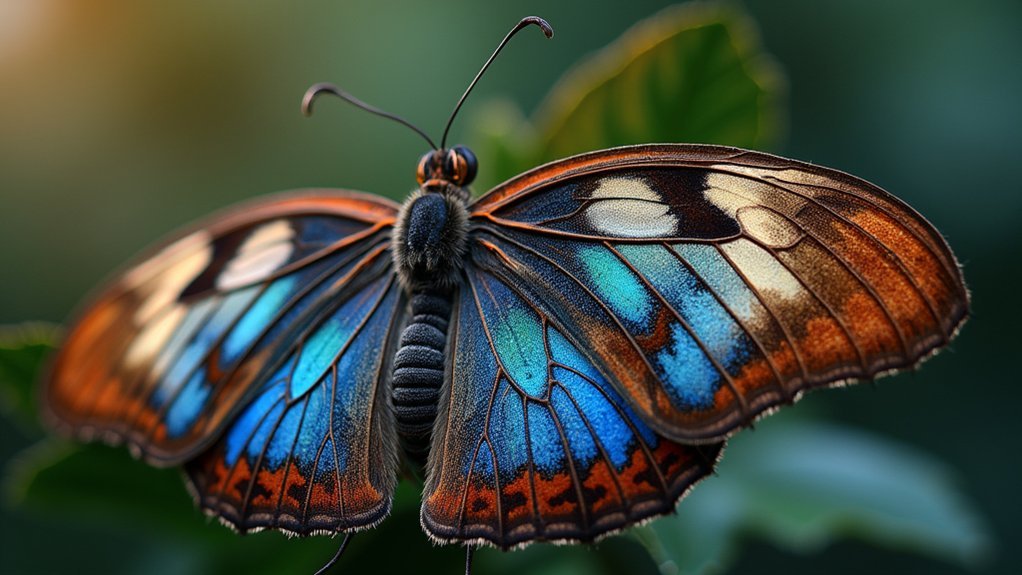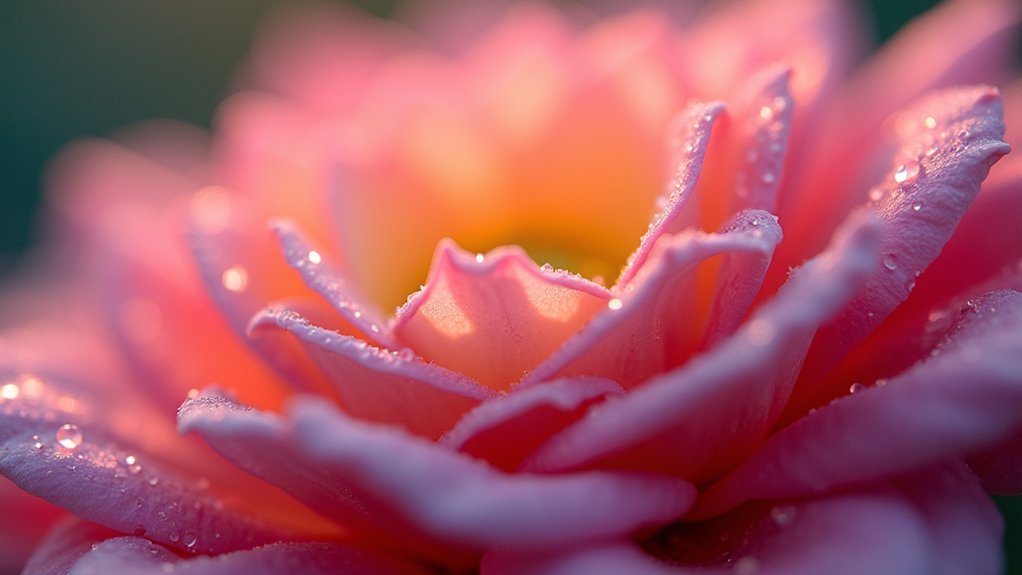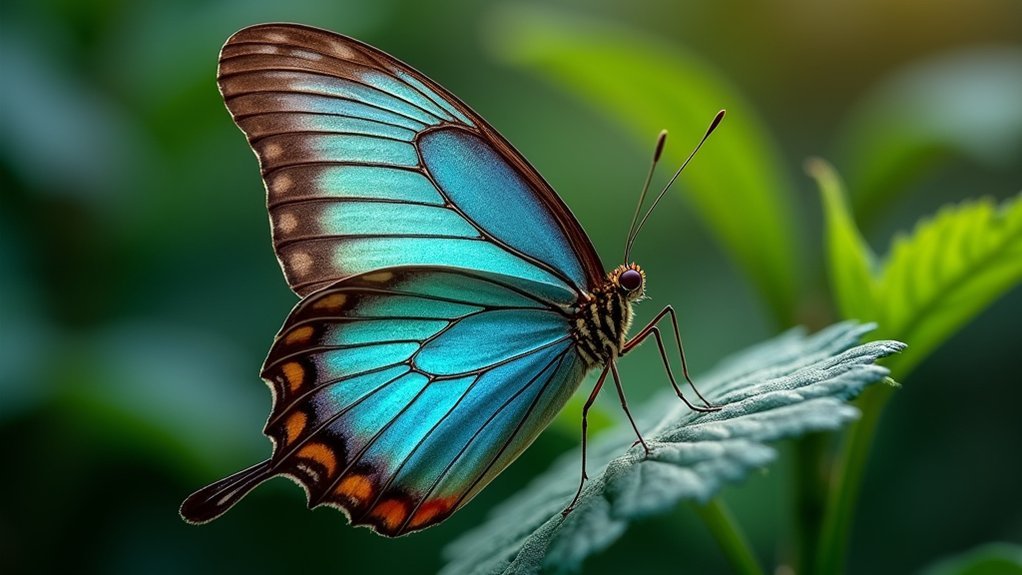You stack multiple images for macro photography because a single shot can’t achieve sufficient depth of field at high magnifications. Even with small apertures (f/8-f/16), only a thin slice of your subject appears sharp. By capturing 20-30 images at different focus points and combining them with software like Helicon Focus or Zerene Stacker, you’ll create one crystal-clear image with complete sharpness throughout. The technique transforms impossible shots into stunning detailed compositions when you master the process.
7 Second-Level Headings

While organizing your focus stacking workflow, you’ll need clear categories to structure your approach.
Consider headings like “Setting Up Your Equipment” to outline your camera and tripod configuration, and “Capturing Different Focus Points” to describe how you’ll photograph each slice of your subject.
Include a “Software Selection” section comparing tools like Helicon Focus with alternatives, and a “Processing Techniques” category explaining how to blend images without artifacts.
Don’t forget “Common Challenges” to address issues like subject movement during macro photography sessions.
Your depth of field concerns deserve their own heading, where you can explore aperture settings and their impact on your final stacked image.
With properly organized sections, you’ll efficiently guide readers through the entire focus stacking process while maintaining technical precision.
The Physics Behind Limited Depth of Field in Macro Photography
When you venture into macro photography, you’ll immediately confront a fundamental optical challenge: extremely limited depth of field.
As your macro lens brings you closer to your subject, physics works against you—light refraction at high magnifications creates pronounced blurring in areas outside your focal plane.
This optical limitation means even with a small aperture (which normally extends depth of field), you’ll capture only a thin slice of sharpness. The circle of confusion becomes so small that precise focus position becomes critical.
While you might try stopping down your aperture further, diffraction will eventually degrade overall image quality.
That’s why focus stacking has become essential for serious macro work—by capturing multiple images at different focus positions and combining them, you’ll overcome physics’ limitations to create crystal-clear macro shots with extensive detail.
Essential Equipment for Successful Image Stacking

Overcoming the physics of limited depth of field requires both technique and the right tools. To capture those crystal-clear macro shots through focus stacking, you’ll need to invest in specialized equipment that guarantees precision throughout the process.
- A DSLR or mirrorless camera with manual settings, ideally with a built-in focus stacking feature, paired with dedicated macro lenses for maximum magnification.
- A sturdy tripod with a focus stacking rail for precise incremental movements between bracketed shots.
- A remote shutter release or electronic trigger to eliminate vibrations when capturing each frame.
These tools work together to help you achieve consistent, shake-free images at different focus points. Without proper stabilization and precise focus control, your stacked images won’t align correctly, resulting in blurry final compositions rather than tack-sharp macro masterpieces.
Step-by-Step Process for Capturing a Perfect Stack
To prepare your stack, guarantee your camera sits on a steady tripod and select an aperture between f/5.6 and f/8 for ideal depth while maintaining image quality.
You’ll need to capture 20-30 focused shots of your subject, systematically moving from the nearest detail to the farthest with consistent lighting throughout.
After shooting, you’ll process your images in specialized software like Zerene Stacker or Helicon Focus, which merges your captures into a single, remarkably detailed final photograph.
Stack Preparation Essentials
Creating a perfect focus stack begins with meticulous preparation that can make or break your macro photography results. Stacking multiple images requires careful attention to your equipment setup and shooting technique to maximize depth of field in your final macro composition.
- Select a rock-solid foundation—a sturdy tripod paired with a remote shutter release eliminates vibrations that could ruin alignment between images.
- Choose aperture wisely—aim for f/5.6 to f/8 for the ideal balance between sharpness and sufficient depth of field across your focus range.
- Maintain consistent lighting throughout your shooting session—strobe lights with diffusers provide even illumination, preventing exposure variations that could complicate stacking.
After capturing your series of precisely focused images, you’ll import them into specialized stacking software like Zerene Stacker or Helicon Focus to merge them into one tack-sharp result.
Post-Capture Processing Workflow
The post-capture workflow transforms your carefully shot image series into one breathtaking macro photograph with complete depth of field.
Begin by importing your macro images into Lightroom, guaranteeing consistent exposure and color before proceeding to the stacking phase.
Next, transfer your edited files to Photoshop as layers. Use Auto-Align to correct slight misalignments before applying Auto-Blend, which merges the sharpest areas from each frame.
For complex subjects with intricate details, dedicated stacking software like Zerene Stacker offers superior edge detection and blending capabilities.
Finally, return your composite to Photoshop for finishing touches. Adjust contrast and saturation to highlight the crystal-clear details that make your macro image stand out.
This methodical post-capture processing guarantees every portion of your subject maintains sharp focus throughout the final image.
Software Options for Combining Multiple Focused Images

When combining multiple focused images for macro photography, selecting the right software becomes essential to achieving the sharp, detailed results you’re after. Your choice will impact the quality of your final composition and workflow efficiency.
- Zerene Stacker excels at edge detection, making it ideal for complex single-shot macro photography where details matter most in your bracketed images.
- Helicon Focus offers user-friendly features and supports various file formats, including RAW images, streamlining your stacking process with efficient merging capabilities.
- Photoshop provides accessibility through its Auto-Align and Auto-Blend features, though you’ll find dedicated stacking programs like Zerene often produce superior results for intricate macro work.
Remember that your source image quality directly affects software performance—capture the best possible bracketed shots for peak stacking results.
Dealing With Movement Challenges in Live Specimen Photography
When photographing live specimens, you’ll need to wind-proof your setup by using weighted tripods and portable shields to minimize subject movement during focus stacking.
You can freeze even subtle movements with precisely timed flash photography, allowing the strobe to capture crisp details while eliminating motion blur in your macro shots.
These techniques work together to overcome one of the biggest challenges in live specimen photography—maintaining perfect alignment across multiple frames despite the unpredictable nature of living subjects.
Wind-Proofing Your Setup
Despite meticulous planning, live specimen macro photography often faces its greatest enemy in the slightest breeze or vibration.
Keeping a steady camera is essential for crisp macro shots, particularly when stacking multiple images.
To effectively wind-proof your setup:
- Mount your camera on a sturdy tripod and use a remote shutter release or 2-second delay to eliminate hand-induced camera shake
- Position your equipment in sheltered locations or create artificial windbreaks using portable screens or umbrellas to shield your subject
- Replace continuous lighting with strobes for consistent lighting without the vibrations that can blur fine details
Choose calm days for outdoor macro sessions whenever possible.
Even indoor setups benefit from these precautions, as air conditioning systems and footsteps can create subtle vibrations that compromise image quality during stacking sequences.
Flash Freezes Movement
Three key advantages make flash an essential tool for overcoming movement challenges in live specimen photography.
First, the incredibly short duration—typically 1/1000th of a second or faster—freezes motion during exposure, capturing sharp details in moving subjects like insects or wind-swayed flowers.
Second, using flash greatly reduces the impact of ambient vibrations that typically plague macro photography, resulting in clearer images of live specimens.
When you add diffusers, you’ll create even light distribution that minimizes harsh shadows and distracting hotspots.
Finally, pairing your flash with a remote shutter release minimizes camera movement, enhancing stability and image clarity.
Remember to balance flash power with ambient light settings to guarantee both your subject and background are properly exposed without introducing unwanted blur.
Advanced Stacking Techniques for Different Magnification Levels

Several key techniques become essential as you venture into higher magnification macro photography.
When capturing crystal details, focus bracketing allows you to maximize depth of field by taking multiple shots at incremental focus distances. Using a focusing rail, move in precise 1-2mm steps between each capture to guarantee complete coverage of your subject.
For best results at various magnification levels:
- Choose the right optics—reversed Nikon enlarging lenses or 4x/10x microscope objectives deliver extraordinary detail
- Select an aperture between f/8 and f/16 to balance depth of field with overall sharpness
- Process your stacks with software like Zerene or Helicon Focus, which excel at aligning and blending multiple images
The number of shots required increases with magnification—don’t hesitate to capture 30+ images for complex subjects.
Frequently Asked Questions
What Is the Purpose of Stacking Photos?
You stack photos to increase depth of field, creating one sharp image from multiple focus points. It’s especially useful in macro photography where you’ll capture intricate details that would otherwise remain blurry.
Why Stack Astro Images?
You stack astro images to reduce noise, reveal faint details, and enhance signal quality. It’s like combining multiple glimpses of the cosmos, allowing you to capture celestial objects with clarity that’s impossible in single exposures.
What Is Stacking in Macro Photography?
Stacking in macro photography is when you capture multiple images at different focus points and combine them into one photo. You’ll get greater depth of field and sharper details than would be possible with a single shot.
How Many Images for Focus Stacking?
You’ll typically need 10-30 images for focus stacking in macro photography. Use more (30+) for tiny subjects or intricate details. Start with 10-20 as a beginner and adjust based on your results.
In Summary
You’ve now mastered the art of focus stacking for macro photography. By combining multiple images at different focus points, you’re overcoming the physical limitations of depth of field. Whether you’re shooting static subjects or live specimens, remember that practice makes perfect. Keep experimenting with different equipment, software, and techniques, and you’ll soon create stunning macro images with edge-to-edge clarity that wasn’t possible with single exposures.





Leave a Reply